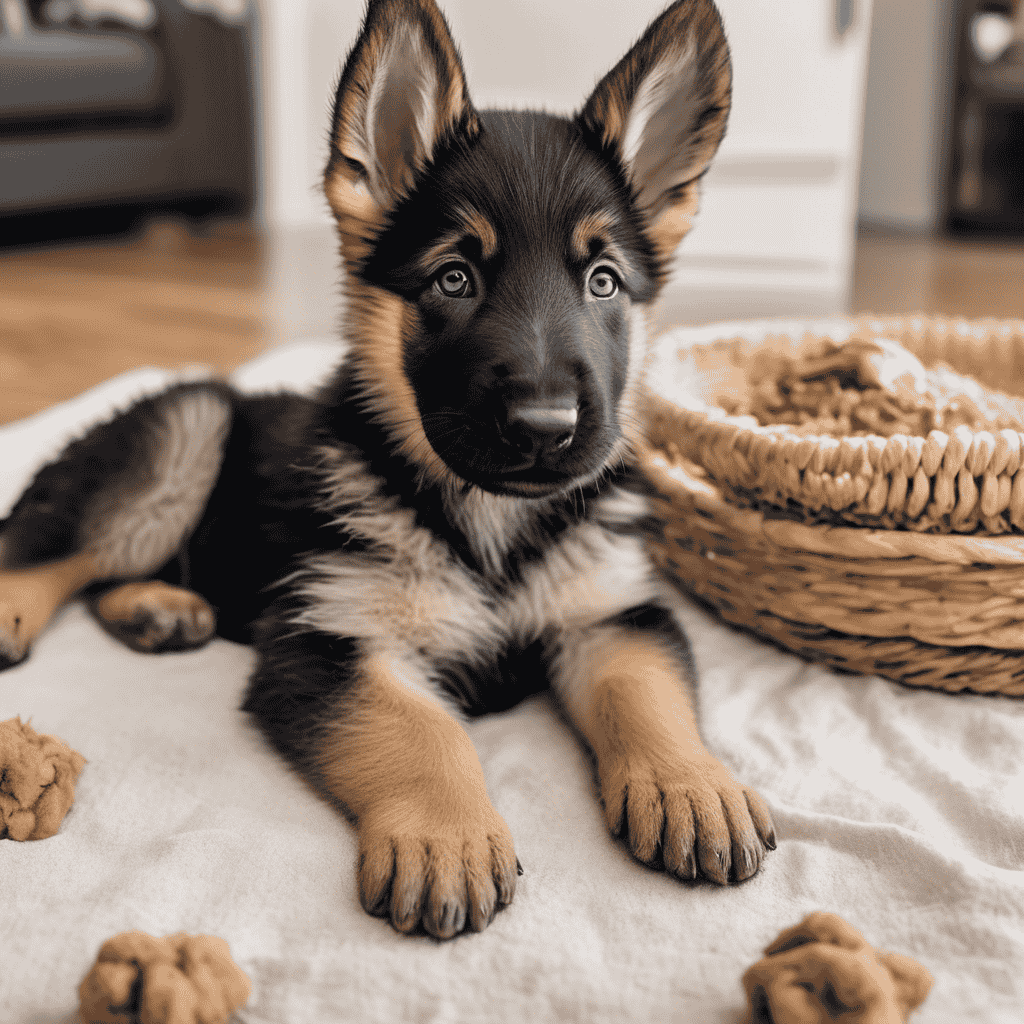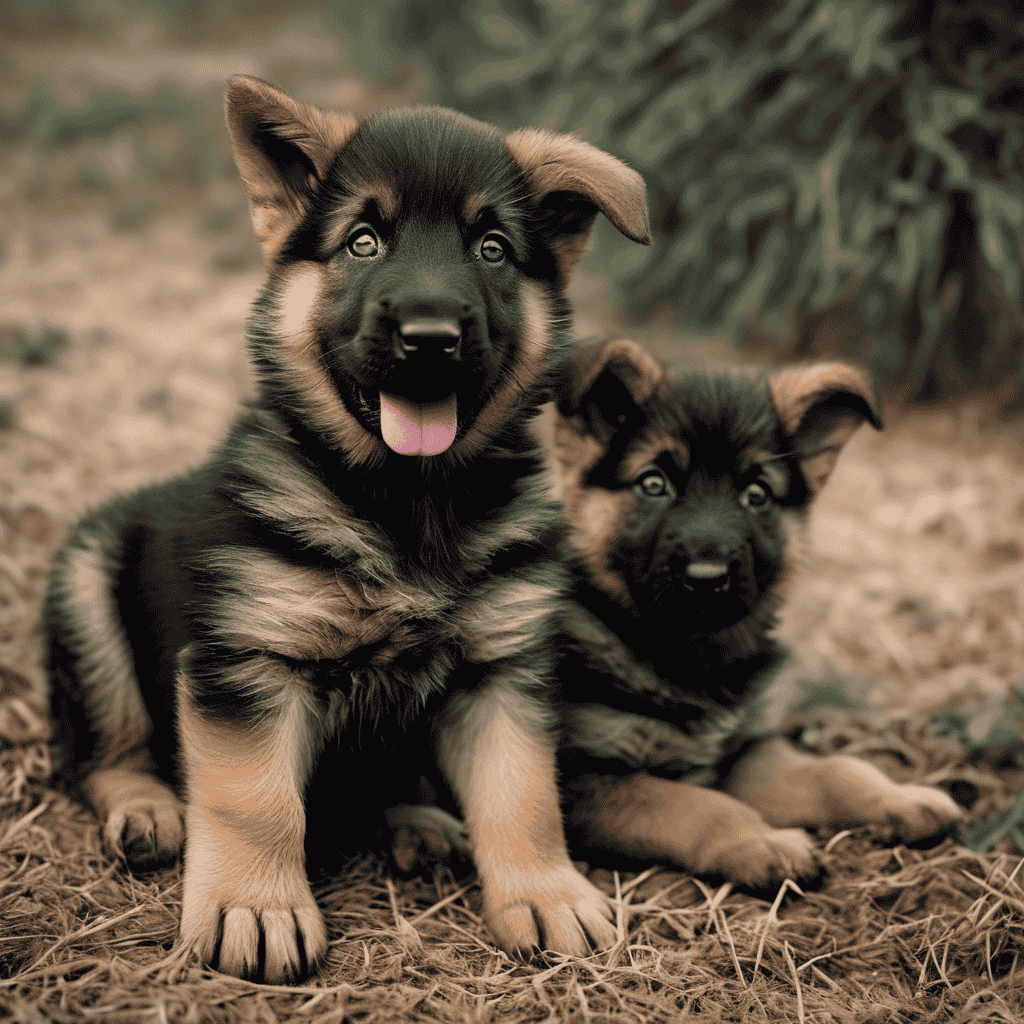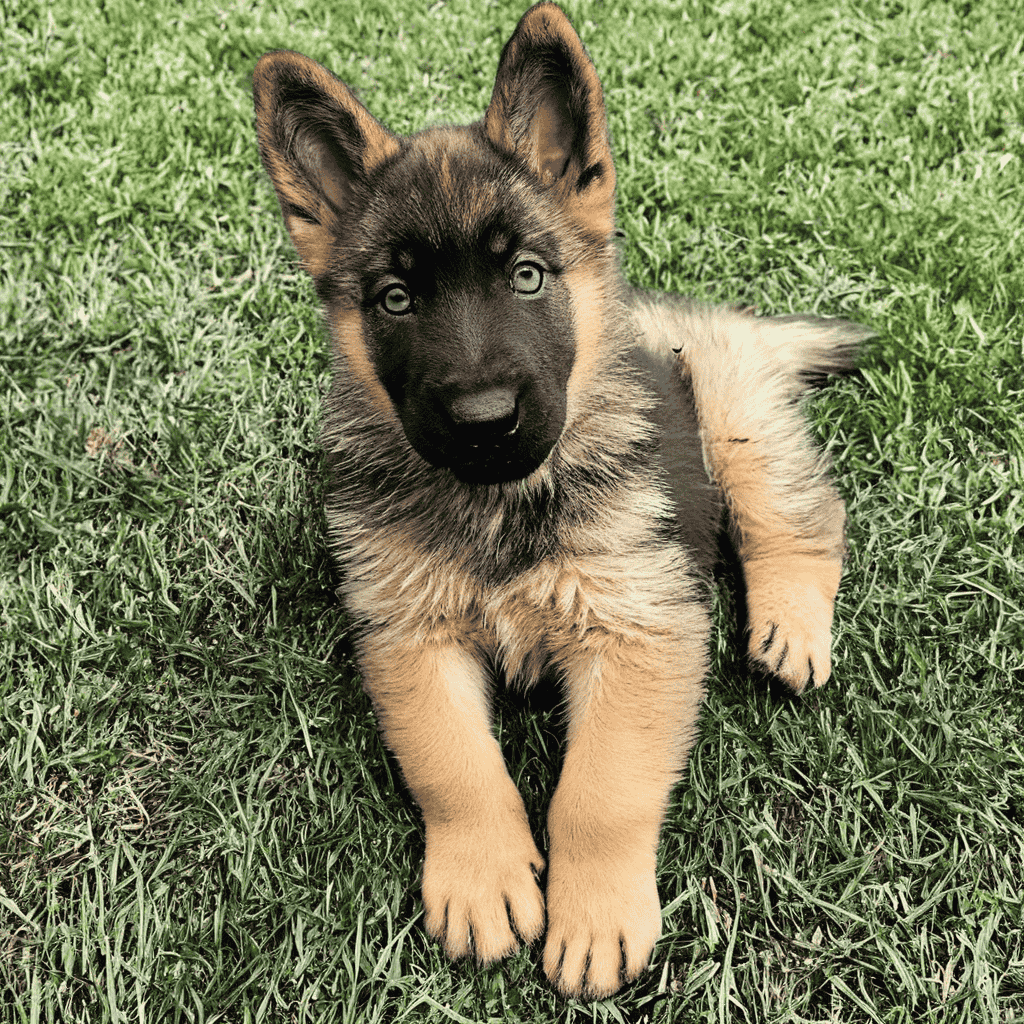German Shepherd puppies come into the world unable to see or hear. They can touch and smell to find their way around. These tiny furry creatures go through amazing changes in their first month alive.
When German Shepherd puppies reach one month old, they’ve already hit some big milestones. Their eyes open up around 10-14 days after birth. They take their first shaky steps at about three weeks. They also start to show their own unique personalities. At four weeks, these pups weigh between 4-8 pounds. From nose to tail, they measure about 8-10 inches. Their coats are soft and fluffy, and their eyes are now fully open. At this stage, their eyes are often blue-gray, but this color will change later. These changes make 1-month-old German Shepherd puppies even cuter as they enter a key time to learn about the world. During this period, they become more curious and like to play more. They still drink their mother’s milk, but they might start to show interest in solid food too.
Curious about the appearance of these puppies when they’re born or how to take care of them during this key growth period? This guide uncovers all the secrets that seasoned breeders know but don’t often talk about regarding a German Shepherd puppy’s first four weeks of life.
Week-by-Week Growth of a Newborn German Shepherd Puppy

“Their eyes start to open around day 14, and their ear canals open up soon after.” — Kaiser German Shepherds, German Shepherd breeder and canine development specialist
The initial month in a German Shepherd puppy’s life marks a time of quick growth. These small dogs change from helpless newborns to engaging, fun-loving puppies in just four weeks. Week 1: Blind, deaf, and reliant
In their first week, German Shepherd puppies sleep about 90% of the time. They rely on their mom for food, warmth, and bathroom needs. Even though they can’t see or hear yet, these newborns use touch and smell to find their way around. Despite not being able to do much, these little pups grow fast, often doubling their weight by two weeks old. When they’re born, they weigh between 0.8 to 1.3 pounds. They just eat and sleep at this stage. spend 90% of their time sleeping
Week 2: Eyes open, first signs of awareness
A big change happens when your puppy turns two weeks old. Their eyes start to open around day 14, but they can’t see much at first. Soon after, their ear canals begin to grow, letting them hear sounds for the first time. At this point, puppies make more noise trying out different sounds like yelps and whines. You’ll also notice they become more aware of what’s around them as their senses get better.
Week 3: Wobbly steps and first barks
The third week is a big deal – your puppy starts moving! They take their first shaky steps and get better at walking. Also, their baby teeth start to come in, and they play with their brothers and sisters in new ways. You begin to see their unique personalities as they become more social. Puppies can now go to the bathroom on their own without their mom’s help and might make their first real barks.
Week 4: Exploring, playing, and teething
When German Shepherd puppies reach one month old, they can walk well, moving like grown-up dogs. They get more curious and check out everything around them. Playing with their brothers and sisters, people, and toys becomes a big part of their day. Their teeth keep growing, and many pups have all their teeth by now. They also start eating soft food while still drinking milk from their mom. You can see their unique personalities more,e making it a great time to introduce them to new things.
What Newborn German Shepherd Puppies Look Like

The small black bundles of fur that make up newborn German Shepherd puppies steal hearts right away with their helpless charm. People recognize this breed, and these puppies go through big physical changes in their first month.
Size and weight at birth and 1 month
When German Shepherd puppies are born, they are tiny, weighing between 0.8 to 1.3 pounds. These little creatures measure just a few inches in length, fitting in your hand. After one month, healthy puppies show big changes in size,e reaching between 4-9 pounds. Most puppies follow a similar growth pattern, doubling their birth weight by the end of their first week. So, you’ll see quick changes as they grow about 5-10% each day during this important time.
Coat texture and color variations
New German Shepherd owners often feel amazed at how their puppies look when they’re born. All German Shepherd puppies come into the world with coats that look almost black. Their fur feels soft and fluffy, which helps keep them warm. These dark colors at birth don’t show what they’ll look like as adults. Puppies that will have the well-known black and tan pattern start dark, with just small tan “socks”. As they grow, these lighter areas spread out while the darker parts shrink into the typical saddle pattern. Sable German Shepherd puppies change – they start brownish, then get lighter to an almost sand color before getting darker again around four to five months.
Eye and ear development
German Shepherd puppies come into the world with their eyes and ears closed, unlike many other animals born with open eyes. Their eyes start to open when they’re about 7-10 days old. At first, their eyes look blue and they can’t focus right away. By the time they’re around 14 days old, their eyes are open. Their ears develop in a specific way too – they’re folded against their heads when they’re born, but stand up as the puppies grow older.
Pictures of newborn German Shepherd puppies
Pictures of newborn German Shepherds show small, defenseless animals with short bodies, wide heads, and strong builds. Their oversized paws and ears (which later stand upright, a hallmark of the breed) create charming images. These big features play a part in making them “one of the cutest breeds of puppy”.
How to Care for a 1-Month-Old German Shepherd Puppy
“When puppies reach the end of their fourth week, they get a lot of their nutrition from puppy food.” — Bow Wow Insurance, a Pet insurance provider specializing in canine health and development
Taking good care of your German Shepherd puppy in its first month sets the stage for its long-term health and behavior. Remember that these little dogs need special care different from grown-up dogs. How to look after newborn German Shepherd puppies
When your German Shepherd puppy is a month old, it still needs a lot of help. Make sure to weigh it every day to check its growth and keep it warm because puppies can’t control their body heat until they’re about 2½ weeks old. By the end of the fourth week, the room should be about 80°F (26.7°C). Also, keep things quiet and peaceful to avoid stressing the puppy while introducing it to new things each day.
Feeding: nursing, milk substitutes, and starting solid food
Four-week-old puppies still nurse but might start to show interest in solid foods. If you need to supplement use milk replacers made for puppies, warmed to about 100°F. To help puppies switch to solids, mix softened puppy food into a slurry. Some breeders give different protein sources early to help puppies handle various meats. However, talk to your vet before you make big changes to their diet.
Keeping the whelping area clean and warm
A clean area stops bacteria from growing and harming young puppies. So, clean the whelping area every day in the first week then twice a day after that. Use disinfectants without chemicals that are safe for puppies, and keep fresh bedding. Make sure there’s a separate spot where the mother can go while the puppies stay in their area.
Handling and early socialization tips
Handle puppies and often to get them used to human touch—this includes their paws, ears, mouth, and tail. This early contact helps make future grooming and vet visits easier. Start to introduce safe new textures, sounds, and experiences. But keep puppies safe from possible illness by limiting their contact with unfamiliar animals until they’ve had all their shots.
Monitoring health and weight gain
Healthy puppies should gain weight. As a rule of thumb, puppies should gain about 1 gram for each pound of expected adult body weight. For example, a German Shepherd puppy should gain around 60-80 grams. Keep an eye out for worrying signs such as:
- The mother nis ot nursing or keeping away from the puppies
- Puppies are fidgety even after nursing
- Puppies lying on their side instead of their chest
- Puppies moving less than their littermates
What Happens Next: Getting Ready for the Second Month

As your German Shepherd puppy nears its second month big changes are in store for both of you. Knowing about these changes will help you get ready for this exciting time.
Changes in behavior and independence
When your German Shepherd puppy turns two months old, you’ll see a clear change in their behavior. They become more independent and full of energy. These pups go from wobbly explorers to confident playmates. Their unique personalities become more obvious as they learn new social skills and start to push limits. You’ll spot big jumps in how much they play, how curious they are, and sometimes how stubborn they can be as they try out new things they can do.
Starting basic training and routines
It’s the best time to set up regular routines. Fixed times for meals, bathroom break,s playtime, training, and bedtime help shape a well-behaved grown-up dog. Start teaching basic commands such as sit down, wait, and come with positive rewards. Puppies at this age enjoy learning to make their owners happy. So, begin crate training to,o giving your pup a safe spot while helping with house training.
When to plan the first vet check-up
Book your puppy’s first doctor visit after they turn 8 weeks old. Before this appointment, get ready by:
- Get any old medical files
- Bring a new poop sample to check for parasites
- Write down questions about food, shots, and growth
To make this visit fun, take treats and toys. Think about carrying your puppy into the clinic instead of letting them walk on floors where they might catch germs from other animals.
What you shouldn’t do during this time
Some things can hurt your puppy’s growth:
- Don’t leave a young puppy alone for more than 2 hours
- Stay away from tough punishments that break trust
- Don’t miss chances to socialize with people and safe places
- Always respect their socialization window (ends at 12-16 weeks)
- Don’t ask for perfect behavior – you need to be patient
Keep in mind that steady, caring guidance helps create the self-assured, balanced companion you want.
Final Thoughts
The first month of your German Shepherd puppy’s life marks a remarkable time of change. These small creatures grow from helpless newborns into engaging, fun-loving companions with unique personalities. During this key period, the right care lays the groundwork to develop a healthy well-adjusted adult dog.
Knowing your puppy’s growth timeline helps you give the right support at each stage. From their first shaky steps around week three to their growing independence by week four, each milestone is worth celebrating. Also, spotting normal growth patterns lets you catch potential problems – important if you see your German Shepherd puppy not eating, which might point to health issues that need quick vet care.
So, as you get ready for your puppy’s second month, keep in mind that patience and consistency are still crucial. Your focus during these key weeks has a big impact on their physical health, emotional balance, and future behavior. The time you put in now builds the strong bond that German Shepherds are known for.
Above all, value these short early weeks. Even with the struggles of late-night feeds and constant watching, this special time flies by. Before you know it, that small dark bundle will turn into the faithful smart friend German Shepherds are known as – and you’ll have played a key part in their path from helpless baby to sure young dog.
FAQs
Q1. How can I take care of a newborn German Shepherd puppy?
Give a warm, clean space and make sure the puppy drinks milk from its mother often. If the mother isn’t there, use milk made for puppies and feed every 2-3 hours. Keep the area free from cold air and keep it at about 80°F (26.7°C). Touch the puppy, but not too much to avoid stress.
Q2. What should I avoid doing with newborn German Shepherd puppies?
Don’t handle them too much, keep them from getting too hot, or put them in drafty places. Stay away from soft bedding that might suffocate them, and make sure their area is quiet and not too bright. Hold off on bringing visitors around too soon to keep the pups from catching anything. Always keep an eye on newborns and don’t leave them alone for long stretches.
Q3. When can I start giving my German Shepherd puppy solid food?
You can begin to offer soft, moist puppy food when your pup is about 3-4 weeks old. To do this, mix top-notch dry puppy food with puppy milk replacer to create a mushy texture. As your puppy grows, cut down on the liquid moving to dry food by the time they’re 6-8 weeks old.
Q4. What is the most important time for newborn German Shepherd puppies?
The first week of life, called the neonatal period, matters most for newborn puppies. This time makes them very weak to cold lack of water, and sickness. They need their mom for heat, food, and care. Keeping a close eye on them and making sure their space is right are key during this time.
Q5. How can I start socializing my German Shepherd puppy?
Start mild socialization when your puppy is about 3-4 weeks old. show the puppy different sights, sounds, and textures in a safe space. Touch and hold the puppy often so they get used to people handling them. As they get bigger bring them to new places, introduce them to people, and let them meet other animals. Make sure all these experiences are good ones to help your puppy feel more sure of itself.
